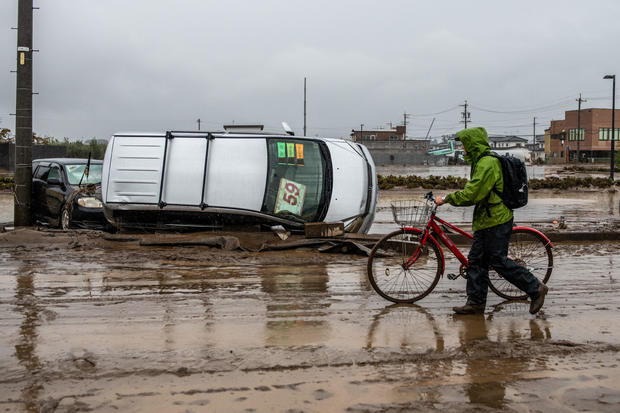Typhoon in Japan leaves dozens dead and many missing as crews race to find victims trapped in mudslides today – CBS News
Nagano, Japan — Rescue crews dug through mudslides and searched near swollen rivers Monday as they looked for those missing from a typhoon that left dozens dead and caused serious damage in central and northern Japan. Typhoon Hagibis unleashed torrents of rain and strong winds Saturday, leaving thousands of homes on Japan’s main island flooded, damaged or without power.
CBS News correspondent Ramy Inocencio said parts of the city that once hosted the Winter Olympics were in ruin; the river that runs through the city breached its levee, destroying homes, flipping cars and toppling power lines.
Getty
Across Japan crews were working around the clock, and more than 110,000 people had joined in the search and recovery efforts using everything from helicopters to their bare hands to help free people trapped in mudslides.
Japan’s official national broadcaster NHK reported that 56 people died from the typhoon, 17 were missing and some 100 were injured. The government’s Fire and Disaster Management Agency, which is generally more conservative in assessing its numbers, said 24 people were dead and nine were missing.
Experts said it would take time to accurately assess the extent of damage, and the casualty count has been growing daily.
Hagibis dropped record amounts of rain for a period in some spots, according to meteorological officials, causing more than 20 rivers to overflow. In Kanagawa prefecture, southwest of Tokyo, 39 inches of rain was recorded over 48 hours.
Some of the muddy waters in streets, fields and residential areas have subsided. But many places remained flooded Monday, with homes and surrounding roads covered in mud and littered with broken wooden pieces and debris. Some places normally dry still looked like giant rivers.
Some who lined up for morning soup at evacuation shelters, which are housing 30,000 people, expressed concern about the homes they left behind. Survivors and rescuers will also face colder weather, with northern Japan turning chilly this week.
Soldiers and firefighters from throughout Japan were deployed to assist with rescue efforts. Helicopters could be seen plucking some of the stranded from higher floors and rooftops of submerged homes.
Prime Minister Shinzo Abe said the government would set up a special disaster team, including officials from various ministries, to deal with the fallout from the typhoon, including helping those in evacuation centers and boosting efforts to restore water and electricity to homes.
Areas in Miyagi and Fukushima prefectures in northern Japan were also badly flooded.
In such places, rescue crew paddled in boats to reach half-submerged homes, calling out to anyone left stranded.
Tokyo Electric Power Co. said 35,100 homes were still without electricity early Monday evening in Tokyo and nearby prefectures that the utility serves. That was down from nearly 57,000 earlier in the day.
East Japan Railway Co. said Hokuriku bullet trains were running Monday but were reduced in frequency and limited to the Nagano city and Tokyo routes.
Tama River in Tokyo overflowed, but the damage was not as great in the capital as in other areas
Much of life in Tokyo returned to normal on Monday. People were out and about in the city, trains were running, and store shelves left bare when people were stockpiling were replenished.




